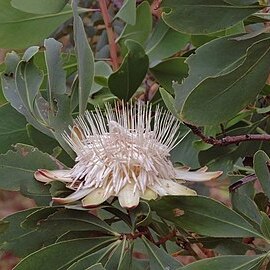Middle bracts (2.5)3–4(4.5) × (1.5)1.7–2.5(3) cm, rounded, dark brown or (particularly in var. trichanthera) purplish, covered with silver or grey-brown appressed hairs or glabrescent in parts towards the margin, or (particularly in var. angolensis) sometimes glabrous or glabrescent throughout; inner bracts (6)7–9 × (0.4)0.7–1.2(1.5) cm, about equalling the flowers, otherwise like middle bracts.
A small straggling tree. It grows up to 3 m high. The bark is black and fissured. The leaves are long and oblong. They are 10-16 cm long by 2-8 cm wide. They are light green and taper to both ends. The flower heads are up to 10 cm across. The bracts are pale green and the flowers generally white. Both can be tinged with pink. The fruit is a nut which is hairy.
Perianth base glabrous outside, with dense hairs near the margin of the upper part inside; claw glabrous or (in var. >i>angolensis) with long whitish hairs inside and occasionally outside; limb (18)20–25(30) mm long, villous on the 3 fused segments, glabrous to pubescent or occasionally villous on the fourth segment.
Either a suffrutex with numerous simple stems up to 1 m high with smooth brown bark or a much branched shrub to bushy tree up to 4(7) m high with dark greyish or purplish bark flaking off to expose brown cortex on young branches.
Leaves up to 17(20) × 10(13) cm, variable in shape (see varieties), glabrous and usually glaucous.
Heads (8)10–15 cm diameter or up to 17 cm when bracts are fully opened.
Flowers (5)5.5–6.5(7) cm long, creamy-white to bright pink.
Style hairy at base.
Shrub, or tree

